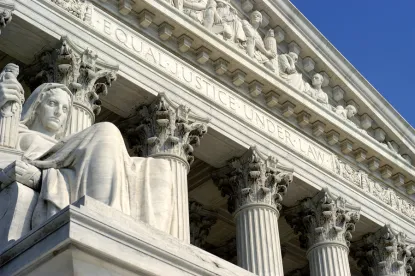Greetings, Court Fans!
While Chief Justice Roberts was busy this week getting ready to preside over his first-ever trial (best to start with something small, like impeachment of the president), the rest of the Court was continuing with business as usual, issuing two new decisions. The Nine have also been at work filling out the remainder of their docket, with a bevy of cert grants over the last few weeks. Let’s get right to it.
The filing of a bankruptcy petition automatically stays all actions proceeding against the bankruptcy petitioner. Creditors who wish to continue with some pre-existing action, then, must ask the bankruptcy court to lift the automatic stay, through filing what is called a “stay-relief motion.” In Ritzen Group, Inc. v. Jackson Masonry, LLC (18-938), the Court was asked to decide whether a bankruptcy court’s order denying a stay-relief motion is a final, immediately appealable order? The unanimous answer: “yes.”
As you may recall from your federal civil procedure class in law school, a party can generally only appeal in a civil case from a “final decision” of the district court. And because a “final decision” usually means a decision that resolves an entire case, prospective appellants typically must wait until the entire case is over and then raise all their arguments in one appeal. But bankruptcy proceedings are a different animal. As the Court has previously observed, a bankruptcy case is made up of numerous “individual controversies, many of which would exist as stand-alone lawsuits but for the bankrupt status of the debtor.” It therefore often happens that a bankruptcy court will finally resolve one controversy, while the umbrella bankruptcy case carries on. Under 28 U.S.C. Section 158(a), those who aren’t happy with how the bankruptcy court has resolved a controversy can appeal any “final judgments, orders, and decrees . . . in cases or proceedings” to a federal district court. Influenced in part by the unique nature of bankruptcy, the Court has interpreted the word “proceedings” to mean that orders in a bankruptcy cases are immediately appealable if they “finally dispose of discrete disputes within the larger bankruptcy case.” But deciding just when an order finally resolves a “distinct dispute” is not always easy.
Enter Ritzen Group and Jackson Masonry. Ritzen agreed to buy land in Nashville from Jackson. After the deal fell through, Ritzen sued for breach of contract in Tennessee state court. Just days before trial, Jackson filed for Chapter 11 bankruptcy. The automatic stay therefore kicked in, putting the Tennessee litigation on hold. Ritzen filed a stay-relief motion in bankruptcy court asking to go ahead with the state-court trial, but the bankruptcy court denied its request. Ritzen did not immediately appeal; instead, it played ball in bankruptcy court, filing a proof of claim. That proved to be a mistake, as the bankruptcy court ultimately decided that it was Ritzen, not Jackson, that had breached the contract. It then disallowed Ritzen’s claim against the estate. Ritzen then filed two notices of appeal to the district court: one challenging the denial of its stay-relief motion and one challenging the bankruptcy court’s resolution of the breach of contract claim. The district court and then the Sixth Circuit held that Ritzen’s first appeal—challenging the bankruptcy court’s refusal to lift the stay—was untimely, because its notice of appeal was filed long after this discrete “proceeding” had been finally resolved.
Justice Ginsburg, writing for a unanimous Court, affirmed. Before the Court, Ritzen argued that the lower courts had gotten it wrong, because its stay-relief motion should be seen as just the first step in the process of adjudicating its claim against Jackson—a process that wasn’t final until the bankruptcy court reached its decision on the merits of Ritzen’s claim—rather than a distinct proceeding. But the Court was not persuaded. Among other things, a stay-relief motion initiates a “distinct procedural sequence” from the merits claim, one governed by federal bankruptcy law rather than the state law that generally governs individual claims in bankruptcy. Moreover, other statutory provisions identify motions to terminate an automatic stay as one of the “core proceedings” of a bankruptcy case, further suggesting that such motions are distinct proceedings for purposes of Section 158(a). Finally, resolution of stay-relief motion can have significant practical consequences—it determines which claims will be resolved inside of the bankruptcy process and which claims outside of it. That only further supports treating a stay-relief motion as a distinct proceeding for purposes of appeal.
So practitioners out there be wary. Once a bankruptcy court resolves a motion for stay-relief, the clock to appeal to the district court begins to run.
This week’s second decision is Retirement Plans Committee of IBM v. Jander (No. 18 1165), a case involving the dread ERISA. And clearly we’re not the only ones who feel that way: Rather than resolving the case on the merits, the Court chose to send it back down to the Second Circuit to consider in the first instance the petitioner’s newly raised arguments.
Under ERISA, managers of an employee stock ownership plan (“ESOP”)—a pension plan comprised primarily of investments in the stock of an employer-company—are charged with acting prudently to safeguard the plan’s assets. But what does this duty of prudence require a company’s plan fiduciaries to do if they have inside information that could affect the value of their company’s stock? Under Fifth Third Bancorp v. Dudenhoeffer, a plaintiff alleging that fiduciaries breached their duty of prudence based on inside information must allege that the plan fiduciaries could have done something other than continuing to invest in the company’s stock. That “alternative action” must be consistent with the securities laws, and a plaintiff must plausibly allege that a prudent fiduciary in the same circumstances would have recognized that the proposed alternative was not likely to do more harm than good to plan beneficiaries.
Larry Jander, a beneficiary of IBM’s ESOP plan, brought a claim like this, alleging that IBM’s retirement plans committee breached its duty of prudence by failing to act on certain inside that, when subsequently disclosed, lowered the value of IBM’s stock. He proposed various alternative actions plan beneficiaries could have taken, including publicly disclosing the negative information themselves. The district court dismissed his suit, concluding that he had failed to plausibly allege that a reasonably prudent fiduciary would have believed this alternative was more likely to help than hurt. But the Second Circuit reversed, holding that Jander’s allegations were enough to get past the pleading stage. The Supreme Court granted cert.
But before the Supreme Court, rather than addressing the issue decided below—whether Jander had adequately pled that the plan’s fiduciaries should have known that Jander’s proposed alternative action was likely to be beneficial—the plan committee’s brief and the brief of the United States as amicus curiae focused on “other matters.” Those matters included whether an ESOP fiduciary had a duty under ERISA to act on inside information at all and whether public disclosure of inside information—the alternative action proposed by Jander—was would conflict with the “objectives” of the securities laws (even if it doesn’t violate them). Rather than decide these arguments that had not been squarely raised below in the first instance, the Supreme Court concluded the better approach was to remand the case back to the Second Circuit. It could then decide whether these arguments were appropriately before the courts at all and, if so, consider their merits.
This per curiam decision wasn’t everything, though. Justice Kagan, joined by Justice Ginsburg, wrote a brief concurrence to make two additional points. First, she emphasized that the Second Circuit should take up whether these newly raised arguments had been waived. Second, she suggested that both the committee and the United States seemed to be making arguments that had already been decided by Dudenhoeffer. On her reading, that decision already imposed some duties on plan administrators to act on inside information, which might include in some cases disclosing information not affirmatively required to be disclosed by the securities laws.
Justice Gorsuch concurred as well but disagreed with Justices Kagan and Ginsburg on several points. First, Justice Gorsuch downplayed the significance of waiver or forfeiture before the Second Circuit, contending that even if the Second Circuit thought these arguments were waived, they might appropriately be considered by the Supreme Court in the future. Second, he argued that Dudenhoeffer was silent on the arguments now before the Court, because the parties in that case had never raised these sorts of arguments either. They therefore raised open questions, albeit ones that should first be addressed by the Second Circuit on remand.
Finally, since our last update, the Court has been busily filling out the remainder of its OT2019 term with new cert grants. We thought we’d close with a quick rundown of the cases the Justices will be deciding later this year (likely in June):
-
Barr v. American Association of Political Consultants Inc. (No. 19-631) asks whether the government-debt exception to the TCPA’s automated-cell restriction violates the First Amendment and (maybe more interesting) whether the appropriate remedy for any constitutional violation is to sever the exception from the remainder of the statute;
-
Rutledge v. Pharmaceutical Care Management (No. 18-540) considers whether an Arkansas statute regulating pharmacy benefit managers’ drug-reimbursement rates is preempted by ERISA.
-
Salinas v. U.S. Railroad Retirement Board (No. 19-199) will decide whether the Railroad Retirement Board’s denial of a request to reopen a prior benefits determination is a “final decision” subject to judicial review.
-
City of Chicago v. Fulton (No. 19-357) asks whether an entity that is passively retaining property in which a bankruptcy estate has an interest has an affirmative obligation under the Bankruptcy Code’s automatic stay provision (remember that?) to return the property to the debtor or the bankruptcy trustee.
-
The companion cases Our Lady of Guadalupe School v. Morrisey-Berru (No. 19-267) and St. James School v. Biel (19-348) will take up whether the First Amendment’s religion clauses prevent courts from adjudicating employment-discrimination claims brought by employees who carry out “important religious functions.”
-
Pereida v. Barr (No. 19-438) considers whether a criminal conviction bars a noncitizen from applying for relief for removal when the record of conviction is ambiguous as to whether it corresponds to an offense listed in the INA.
-
Torres v. Madrid (No. 19-292) asks whether an unsuccessful attempt to detain a suspect by physical force is a “seizure” for the purposes of the Fourth Amendment, or must the attempted detention be successful.
-
McGirt v. Oklahoma (No. 18-9526) will take up whether Oklahoma has the authority to bring criminal charges against an enrolled member of the Creek tribe for crimes committed within the Tribe’s historical boundaries. If that sounds familiar, it’s because the Court took up the same issue last year in Carpenter v. Murphy, but punted because Justice Gorsuch was recused (leading to concerns about a possible 4-4 split).
-
U.S. Agency for International Development v. Alliance for Open Society International (No. 19-177) returns to an issue decided way back in 2013 in an identically captioned case. Then, the Court held that the First Amendment prohibits the enforcement of a federal statute requiring NGOs receiving federal grants to fight AIDS to have a policy “explicitly opposing prostitution.” This go around, the Court will decide whether the First Amendment bars enforcement of that same directive with respect to legally distinct—but affiliated—foreign entities operating overseas.
-
And circling back to where we began this update, the Court granted cert in a trio of Trump cases: Trump v. Vance (No. 19-715) addresses whether a grand jury subpoena served on a custodian of Trumps’ personal records for ten years of tax returns violates Article II and the Supremacy Clause. Trump v. Mazars USA, LLP (No. 19-715) asks whether the House Committee on Oversight and Reform has the constitutional and statutory authority to issue a subpoena to Trump’s accountant for his financial records. And Trump v. Deutsche Bank AG (No. 19-760) asks the same regarding a subpoena served by the House Committee on Financial Services on Trump’s bank.
The Court still has a few more spots on its docket for cases to be argued and decided later this term, which we expect it to fill out within the next week. We’ll be back to update you on that and any new decisions when the time comes.





 />i
/>i

